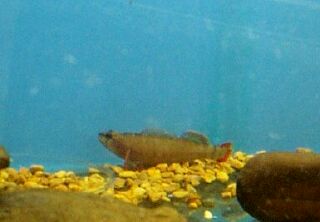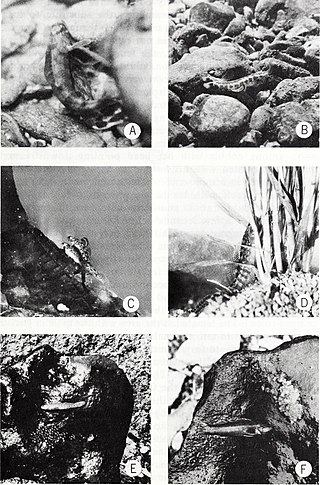
The watercress darter is a species of freshwater ray-finned fish, a darter from the subfamily Etheostomatinae, part of the family Percidae, which also contains the perches, ruffes and pikeperches. It is endemic to the eastern United States where it is only known from the Black Warrior River drainage basin near Birmingham, Alabama.

The yellowcheek darter is a species of freshwater ray-finned fish, a darter from the subfamily Etheostomatinae, part of the family Percidae, which also contains the perches, ruffes and pikeperches. It is endemic to the eastern United States where it is only known to occur in the state of Arkansas in the Little Red River. It inhabits medium-sized and smaller rivers in rocky riffles with strong current. This species can reach a length of 7.2 centimetres (2.8 in) TL though most only reach about 4.9 centimetres (1.9 in).
The Bayou darter is a rare species of freshwater ray-finned fish, a darter from the subfamily Etheostomatinae, part of the family Percidae, which also contains the perches, ruffes and pikeperches. It is endemic to western Mississippi in the United States, where it is found only in Bayou Pierre and its tributaries. Its typical habitat is fast-flowing creeks and streams, in riffles and in areas between riffles with firm gravel bottoms. It feeds on small insects and their larvae. Breeding probably takes place twice a year, in spring and late summer. The population of this fish is declining due to loss of suitable habitat. This is caused by siltation and pollution, particularly erosion caused by changes in land use. The International Union for Conservation of Nature has assessed its conservation status as being "endangered".

The teardrop darter is a species of freshwater ray-finned fish, a darter from the subfamily Etheostomatinae, part of the family Percidae, which also contains the perches, ruffes and pikeperches. It is endemic to the eastern United States. It is only found in Kentucky and Tennessee, where it occurs in the middle to upper reaches of the Green River drainage. It inhabits small rivers and creeks and rocky pools where it feeds on the larvae of blackflies and midges, immature stages of caddisflies and mayflies, and cladocerans and copepods. This species can reach a length of 6 cm (2.4 in), though most only reach about 4.2 cm (1.7 in). This species creates nests in which the females deposit their eggs and these are guarded by the male and have been found to contain between 40 and 80 eggs. The teardrop darter was first formally described by Robert A. Kuehne and James W. Small Jr. in 1971 with the type locality given as Brush Creek, a tributary of the Green River, 2.7 miles north of Liberty, Casey County, Kentucky. The specific name honours Professor Roger W. Barbour (1919-1993) in recognition of his contribution to the knowledge of Kentucky's vertebrate fauna.
The stone darter is a species of freshwater ray-finned fish, a darter from the subfamily Etheostomatinae, part of the family Percidae, which also contains the perches, ruffes and pikeperches. It is endemic to the eastern United States.

The greenbreast darter is a species of freshwater ray-finned fish, a darter from the subfamily Etheostomatinae, part of the family Percidae, which also contains the perches, ruffes and pikeperches. It is endemic to the southeastern United States, where it occurs in the systems of the Alabama River and the Black Warrior River. It is an inhabitant of streams and rocky riffles of creeks and smaller rivers. This species can reach a length of 7.9 cm (3.1 in), though most only reach about 5 cm (2.0 in).

The Highland Rim darter is a species of freshwater ray-finned fish, a darter from the subfamily Etheostomatinae, part of the family Percidae, which also contains the perches, ruffes and pikeperches. It is endemic to the eastern United States, where it is only known to occur in Tennessee and Kentucky in the Barren River system. This species can reach a length of 5.6 centimetres (2.2 in) SL.
The stripetail darter is a species of freshwater ray-finned fish, a darter from the subfamily Etheostomatinae, part of the family Percidae, which also contains the perches, ruffes and pikeperches. It is endemic to the eastern United States. It is found in small rivers and streams in the states of Tennessee, Ohio, Kentucky, Illinois, Alabama, Georgia, and Mississippi. Males are a golden-orange color with black barring on the fins, and grow to a length of about 2.8 in (7 cm). This fish feeds on midge larvae and other small invertebrates. It breeds in the spring; eggs are attached to the substrate, often under slab rocks, where they are guarded by the male. The population trend of this fish seems to be stable and it is a common species with numerous sub-populations over a wide range, and the International Union for Conservation of Nature has assessed its conservation status as being of "least concern".
The lollipop darter is a species of freshwater ray-finned fish, a darter from the subfamily Etheostomatinae, part of the family Percidae, which also contains the perches, ruffes and pikeperches. It is endemic to the eastern United States. Lollipop darters are approximately 1.4 to 2.4 inches long.
The blackfin darter is a species of freshwater ray-finned fish, a darter from the subfamily Etheostomatinae, part of the family Percidae, which also contains the perches, ruffes and pikeperches. It is endemic to the eastern United States where it occurs in the Tennessee River drainage, being found from the Paint Rock River to the Duck River system. It is an inhabitant of small rivers and creeks, living in small pools and nearby riffles. This species can reach a length of 8.8 centimetres (3.5 in) TL.
The barcheek darter is a species of freshwater ray-finned fish, a darter from the subfamily Etheostomatinae, part of the family Percidae, which also contains the perches, ruffes and pikeperches. It is endemic to the eastern United States where it is only known to occur in the states of Kentucky and Tennessee in the Cumberland River drainage from the Big South Fork down to the Obey River. It is an inhabitant of smaller rivers, streams and creeks where it lives in small, rocky pools. This species can reach a length of 8.4 centimetres (3.3 in) TL though most only reach a length of 5 centimetres (2.0 in).
The firebelly darter is a species of freshwater ray-finned fish, a darter from the subfamily Etheostomatinae, part of the family Percidae, which also contains the perches, ruffes and pikeperches. It is endemic to the eastern United States, where it is only known to occur in the drainage systems of the Obion and Forked Deer rivers of Kentucky and Tennessee. It inhabits gravel or sand-bottomed pools in creeks up to small rivers. This species can reach a length of 7 centimetres (2.8 in) TL.
The spottail darter is a species of freshwater ray-finned fish, a darter from the subfamily Etheostomatinae, part of the family Percidae, which also contains the perches, ruffes and pikeperches. It is endemic to the eastern United States. It is found in the Ohio River basin and in the Red River system of the Cumberland River drainage. It inhabits rocky pools and nearby riffles of flowing waters up to the size of small rivers.
The bandfin darter is a species of freshwater ray-finned fish, a darter from the subfamily Etheostomatinae, part of the family Percidae, which also contains the perches, ruffes and pikeperches. It is endemic to the eastern United States. It occurs in tributaries of the lower Tennessee River system and uppermost Black Warrior River system. This species inhabits gravel and sandy pools in flowing waters up to the size of small rivers. It can reach a length of 7.1 centimetres (2.8 in) TL.

The Cherokee darter is a rare species of freshwater ray-finned fish, a darter from the subfamily Etheostomatinae, part of the family Percidae, which also contains the perches, ruffes and pikeperches. It is endemic to Georgia in the United States, where it is limited to the Etowah River system. It inhabits creeks with rocky bottoms and little silt, typically occurring just above and below riffles. It is a whitish or yellowish fish with green and black spots on the flanks and eight dark saddle-like bars dorsally. It has a small range and its habitat is being degraded and fragmented, and the International Union for Conservation of Nature has assessed its conservation status as being endangered.

The relict darter is a rare species of freshwater ray-finned fish, a darter from the subfamily Etheostomatinae, part of the family Percidae, which also contains the perches, ruffes and pikeperches. It is endemic to Kentucky, where it occurs only in the drainage of the Bayou du Chien. It is a federally listed endangered species of the United States.
The Carolina fantail darter is a small species of freshwater ray-finned fish, a darter from the subfamily Etheostomatinae, part of the family Percidae, which also contains the perches, ruffes and pikeperches. It is endemic to the eastern United States, where it occurs in the Santee and Savannah River drainages and Yadkin River system of the Pee Dee River drainage in North Carolina, northern South Carolina and southern Virginia. This species can reach a length of 6.3 cm (2.5 in).
The Tuskaloosa darter is a species of freshwater ray-finned fish, a darter from the subfamily Etheostomatinae, part of the family Percidae, which also contains the perches, ruffes and pikeperches. It is endemic to Alabama in the United States, where it occurs only in the upper Black Warrior River drainage, with disjunct populations occurring in the Locust Fork system and upper Sipsey Fork systems.
The brook darter is a small species of freshwater ray-finned fish, a darter from the subfamily Etheostomatinae, part of the family Percidae, which also contains the perches, ruffes and pikeperches. It is endemic to the eastern United States, where it occurs in the upper Black River system in Missouri, from headwaters to where the River flows into the Mississippi River alluvial plain. It inhabits shallow gravel riffles, sometimes rocky runs and pools, of headwaters, creeks, and small rivers. The brook darter was first formally described in 1997 by Patrick A. Ceas and Lawrence M. Page with the type locality given as the Black River on the northeastern outskirts of Mill Spring, Missouri. The specific name honours Brooks M. Burr, Emeritus Professor and Curator of Fishes of Southern Illinois University who first brought the fish to the attention of the authors.
The Tennessee darter is a species of freshwater ray-finned fish, a darter from the subfamily Etheostomatinae, part of the family Percidae, which also contains the perches, ruffes and pikeperches. It is endemic to the eastern United States, where it occurs in the Tennessee River drainage from western Virginia to western Tennessee. It also occurs in the upper Bluestone River drainage in western Virginia. It inhabits current-swept rocky pools and adjacent riffles of creeks and small to medium rivers. This species can reach a length of 6 cm (2.4 in).








